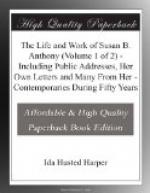Subsequent events show that this lady was failing rapidly with consumption. Among the old letters, one from an assistant teacher to Daniel Anthony, dated 1839, a year after Susan left school, says: “The tender chord that so long confined our beloved Deborah to this world was broken on the 25th day of the 4th month, and we trust her happy spirit took its flight to realms of eternal felicity.” Deborah Moulson was a cultured and estimable woman, but she represented the spirit of that age toward childhood, one of chilling severity and constant repression, when reproof was as liberally administered as praise was conscientiously withheld.
[Footnote 4: Sixty-five years later, this cousin, Nancy Howe Clark, aged eighty-seven, wrote Miss Anthony:
“The year I spent at your father’s was the happiest of my whole long life. How well I remember the sweet voices saying ‘Cousin Nancy,’ and the affectionate way in which I was received by your dear father and mother. It had never been my fortune before to live in a household with an educated man at its head, and I felt a little shy of your father but soon found there was no occasion. Although it was a period of great financial depression, he always found time to be social and kindly in his family. He seemed to have an eye for everything, his business, the school and every good work. I considered your father and mother a model husband and wife and found it hard to leave such a loving home.”]
[Footnote 5: In later years the younger children were instructed on piano and violin, and he enjoyed nothing better than listening to them.]
[Footnote 6: In reading them over, sixty years afterwards, she said mournfully, “That has been the way all my life. Whenever I take a pen in hand I always seem to be mounted on stilts.” To those who are acquainted with her simple, straightforward style of speaking, this will seem hardly possible, yet it is probably one of the reasons which led her, very early in her public career, to abandon all attempts at written speeches.]
CHAPTER III.
Financial crash—the teacher.
1838—1845.
The prosperous days of the Anthonys were drawing to a close. All manufacturing industries of the country were in a ruinous state. The unsound condition of the banks with their depreciated and fluctuating currency had created financial chaos. Overproduction of cotton goods on a credit basis, inordinate speculation, reduction of duties on importations, produced the inevitable result, and the commercial world began to totter on its foundations. The final ruin is foreshadowed in the letters of Daniel Anthony. In one to his brother September 2, 1837, he says:
I am going next week on a tour of the eastern cities and when I return shall be prepared to face the situation. My goods at present will not sell for the actual cost of manufacturing. Van Buren’s message has just made its appearance. It is opposed to banks and may operate unfavorably to business, but how it can be worse I don’t know.
He writes from Washington to his wife, September 11:




